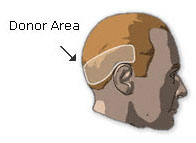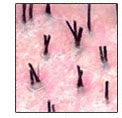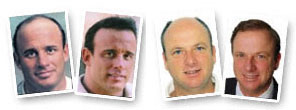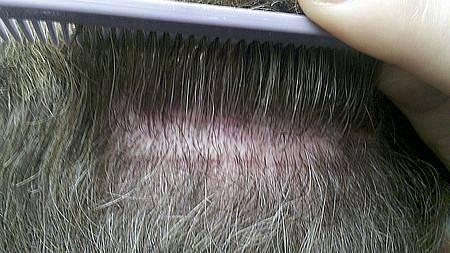From plugs to natural follicular units.
Hair transplantation has evolved a long, long way since it began in the early 1950's. The "corn row" or "doll's" hair look that was associated with hair transplantation has evolved into today's "follicular unit" procedure that, when done right, is undetectable even by a hair stylist.

The Concept of Hair Transplantation is Born.
During the past several decades, superstition, old wives tales, and guess work has gradually been replaced by science.
In 1939, a Japanese dermatologist, Dr. Okuda, published a revolutionary method in a Japanese medical journal of using small grafts that was similar to the way hair transplantation is performed today.
This method involved using hair transplant grafts to correct lost hair from various areas, including the scalp, eyebrow, and moustache areas. However, this study didn"t make an impact in the Western Hemisphere due to the interruption of World War II.

Hair Restoration Comes of Age.
In the late 50's one physician in particular, Dr. Norman Orentreich, began to experiment with the idea of relocating or transplanting the hair on the back and sides of the head to the balding areas.
Dr. Orentreich's experiments showed that when bald resistant hairs from the back and sides of the head were relocated, they maintained their bald resistant genetic characteristic regardless of where they were transplanted.
This principle, known as "Donor Dominance", established that hair could be transplanted from the bald resistant donor areas to the balding areas and continue to grow for a life time. This laid the foundation for modern hair transplantation.
 During the 60's and 70's hair transplants grew in popularity. However, the standard of care involved the use of larger grafts that were removed by round punches and often contained many hairs.
During the 60's and 70's hair transplants grew in popularity. However, the standard of care involved the use of larger grafts that were removed by round punches and often contained many hairs.
This now outdated hair transplant technique could achieve good results with a full look if a patient completed all planned sessions. However, a patient was typically limited in the manner they could style their hair and, unfortunately, many patients ran out of donor hair before the hair transplant process could be completed.
From a few large grafts to many small grafts.
In the 80's hair restoration surgery evolved dramatically, as the large punch grafts were gradually replaced with a more refined combination of mini and micrografts. This "combination mini micrografting" hair transplantation procedure no longer used the punch to extract the bald resistant grafts. Rather a strip of bald resistant hair was surgically removed from the back of the head and then trimmed into mini and micrografts.
Typically the minigrafts (4-8 hairs) were used to create fullness and density, while the one, two, and three hair micrografts were used to create a refined and feathered hairline in front. This combination procedure also normally used more grafts, several hundred grafts per session, rather than the approximately 50 to 200 large grafts of the original punch graft procedure.
Follicular Unit Hair Transplantation (FUT)
the "Gold Standard".
 The 90's saw the gradual introduction of a very refined surgical procedure now known as "follicular unit hair transplantation" or "FUT". This exacting and labor intensive procedure transplants hairs in their naturally occurring one, two, three, and four hair "follicular unit groupings" in which they grow naturally.
The 90's saw the gradual introduction of a very refined surgical procedure now known as "follicular unit hair transplantation" or "FUT". This exacting and labor intensive procedure transplants hairs in their naturally occurring one, two, three, and four hair "follicular unit groupings" in which they grow naturally.
To create such natural follicular unit grafts, which mimic the way hair grows naturally, typically requires the use of high powered magnification. Such magnification enables the surgical technicians to properly visualize the follicular units in the donor tissue. They are then able to isolate them and cut them into 1, 2, 3, and some times 4 hair follicular unit grafts.
The concept of creating the entire hair restoration using exclusively follicular units was proposed by Dr. Robert Bernstein and was described in the 1995 Bernstein and Rassman publication "Follicular Transplantation." Critical to the success of the follicular unit hair transplant procedure was the introduction of the binocular microscope by Dr. Bobby Limmer of San Antonio Texas in the late 1980's. Dr. Limmer found that by using the microscope to examine the donor tissue he and his staff were able to successfully isolate and trim the naturally occurring follicular units into individual grafts. Dr. Limmer shared his techniques and findings with his collogues and together with Drs. Bernstein, Rassman and Seager, was a persuasive advocate for the follicular unit hair transplant procedure.

Over time the merits of this refined, but difficult to perform, procedure became accepted and the follicular unit hair transplant procedure has become acknowledged by most hair restoration physicians to be the "Gold Standard" for surgical hair restoration.
Some feel that hair restoration surgery has evolved to its highest degree now that it relocates hair exactly as it grows naturally. However, even the "Gold Standard" in hair transplantation has continued to evolve by becoming even more "ultra refined".
Today some leading hair restoration surgeons, including all members of the Coalition of Independent Hair Restoration Physicians, perform an ultra refined follicular unit hair transplant procedure using very tiny incisions that enable them to safely "dense pack" tiny grafts when appropriate. This ultra refined follicular unit procedure enables patients to achieve cosmetic density in a given area after only one surgical session.
Click to learn more about "Ultra Refined Follicular Unit Hair Transplantation".
The "Old" Hair Transplants.
 Patients who stopped short of completing all planned sessions were left with hair transplants that looked obvious and unnatural. Such uncompleted hair transplant results are some times referred to as "Barbie doll hair" or "corn rows".
Patients who stopped short of completing all planned sessions were left with hair transplants that looked obvious and unnatural. Such uncompleted hair transplant results are some times referred to as "Barbie doll hair" or "corn rows".
Many who have had these older techniques now refine or complete their hair transplants with today's very refined techniques to achieve a natural look that they can style in any manner.
The "Snake Oil" Years.
The early 1800's is renowned in hair restoration circles as the age of the con men.
 There were hundreds of hair restoration treatments released and many lasted well into the late 1900's. These "cures"were marketed by "doctors," whose only skills were those of fast-talking and nerves of steel (as well as bravery, considering they were conning hardened cowboys and outlaws!).
There were hundreds of hair restoration treatments released and many lasted well into the late 1900's. These "cures"were marketed by "doctors," whose only skills were those of fast-talking and nerves of steel (as well as bravery, considering they were conning hardened cowboys and outlaws!).
The salesmen hawked their products from the safety of their side shows and "Wild West" spectaculars. They used endless tricks to get people to buy their products, such as rubbing grease into people's hair, to make it look thicker.

Today's Natural Results.
Today's follicular unit hair transplantation, when done right, can produce results so natural that even a barber will not know you did it.
View more hair transplant photos.
To learn more about hair restoration surgery and explore animations and videos of these procedures visit our surgical treatments

















